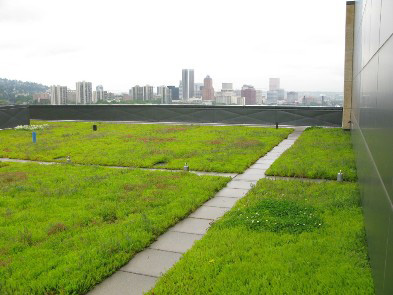 The worldwide eco-roof industry is growing rapidly, and Portland is often lauded as being in a unique position to benefit as an early adopter of the green building trend. Yet the city is falling behind on its goal of 43 acres of eco-roofs by 2013.
The worldwide eco-roof industry is growing rapidly, and Portland is often lauded as being in a unique position to benefit as an early adopter of the green building trend. Yet the city is falling behind on its goal of 43 acres of eco-roofs by 2013.
BY EMMA HALL
 |
OHSU Ecoroof, photo courtesy of Portland Bureau of Environmental Services |
The worldwide eco-roof industry is growing rapidly, and Portland is often lauded as being in a unique position to benefit as an early adopter of the green building trend. The city has joined much larger cities in offering green roof incentives since 2008, and is home to startup eco-roof manufacturer Columbia Green. Portland State University boasts a Green Roof Design and Testing Lab. Yet the city is falling behind on its goal of 43 acres of eco-roofs by 2013.
Vegetated roof systems reduce and treat stormwater, fight air pollution and sequester carbon dioxide. As part of the sustainable stormwater management practices program Grey to Green, Portland pays up to $5 per square foot for new eco-roof projects within city limits. The roofs cost between $5 and $20 per square foot, and that price is expected to come down as they become more common. Grey to Green’s goal is to reach 43 acres of green roofs by 2013. However, as of July 2012 the city had only 355 eco-roofs on Portland homes and businesses, totaling 17.7 acres.
Driven by incentives like Portland’s across the world, the green roof and wall business will become a $7.7 billion market by 2017, says a new report by Lux Research. Poised to benefit from that is green-roof pioneer Columbia Green. In September, Columbia Green received a $80,000 commercialization grant from Oregon BEST to partner with Portland State University researchers on measuring and tracking the ability of ecoroof systems to manage stormwater runoff in urban settings. The PSU research team is led by Graig Spolek, who runs the university’s Green Roof Design and Testing Lab. The collaboration hopes to quantify the benefits of eco-roofs, backing up claims being made by the young industry.
The market for green roofs grew 115% in 2011, according to industry trade group Green Roofs for Healthy Cities. “We are definitely beginning to see results from policy support that has increased over the past few years,” said GRHC Chair Jeffrey L. Bruce in a press release. “The industry is also benefitting from the more than 500 accredited Green Roof Professionals (GRPs) in the market, who are committed to driving future industry growth.”
Besides their environmental aspects, green roofs hold the possibility of being beautiful green additions to dreary concrete jungles, or even provide recreation value. Portland-based Surround Architecture recently completed a 1,400-square-foot green roof on Turtle Island Foods’ new riverfront production facility in Hood River. “The design of the green roof evolved,” Surround Architecture creative director Mark VanderZaden said. “We specified deeper soil than the typical green roof so it could have areas to grow vegetables and taller accent plants, designed a bocce ball court, incorporate seating areas and walkways, and wired the roof for sound so music can be enjoyed outside. Mini-golf holes with an environmental theme are still to be added.”
So if green roofs can help the environment and look cool, why aren’t more developers creating them in Portland? The market may be growing internationally, but still lags behind in Columbia Green’s hometown. The failure of green building pioneers like the much-lauded Oregon Sustainability Center shows that local support for green building efforts can balk in the face of high price tags. A Portland study from 2008 did a detailed cost analysis on eco-roofs. Compared to a traditional roof, a 40,000-square-foot eco-roof would cost $128,803 more after five years, but save $403,632 for the property owner after 40 years. And with the economy the way it is, people are looking at short-term costs rather than long term savings. PSU’s Green Building Research Center has an online Green Roof Energy Calculator that is partially funded by the U.S. Green Building Council. Try it yourself to see if a green roof could be right for you.
Portland property owners and developers can get more information on how to apply for the eco-roof incentive at the Bureau of Environmental Services’ website.
Emma Hall is the web editor of Oregon Business.

